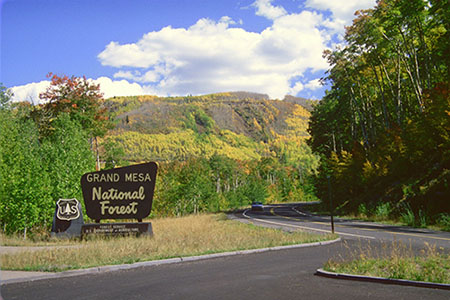Our series travelling Colorado’s Scenic and Historic Byways continues around the Grand Mesa! The Grand Mesa Scenic and Historic Byway crosses what is locally known as the world’s largest flat-top mountain through a range of desert and subalpine landscapes in Western Colorado.

Grand Mesa is a 63-mile route that climbs through the Plateau Creek Canyon off of I-70 and ends in Cedaredge, with a spur about halfway through leading to the Land’s End Overlook. Along the way, the byway passes through evergreen forests and hundreds of lakes in the Grand Mesa National Forest – a big contrast to the hot, dry desert a few thousand feet below! Grand Mesa was designated as a Colorado Scenic and Historic Byway in 1991, a U.S. Forest Service National Scenic Byway in 1992, and as a National Scenic Byway in 1996. Grand Mesa is also a Colorado Electric Byway, meaning that vehicle charging infrastructure is available close to the start and end of the route.
“Mesa” is the Spanish word for “table,” making Grand Mesa is an apt name for the flat-topped mountain with steep sides. The plateau at the summit of Grand Mesa covers about 500 square miles and averages 10,000 feet of elevation, about 6,000 feet higher than the town of Grand Junction at its base. The Mesa’s geologic history is interesting; the summit of the mountain used to be a low valley that was filled with lava, creating a flat layer of volcanic basalt. Basalt is a very durable rock that remined intact while the softer sedimentary rocks around the Mesa were eroded by the Colorado and Gunnison Rivers. This means that what used to be the lowest point in the landscape is now the highest, a phenomenon called “topographic inversion.” A guide published by the U.S. Forest Service explains the process, and many more of the unique geological features that are showcased along the Grand Mesa Byway.
Grand Mesa’s plateau summit is home to over 300 lakes and reservoirs that support thriving wildlife communities. Visitors can spot porcupine, elk, coyotes, and occasionally mountain lions on land, and plenty of trout in the water. With all that access to water, it’s no surprise that fishing is a popular recreational activity up on the mesa. Fishing the Grand Mesa, published by Colorado Parks and Wildlife, provides detailed information for about 100 of the Mesa’s many lakes as well as a chart to help anglers tell the difference between the four species of trout they might encounter.
- Colorado state parks: St. Vrain - August 8, 2025
- Peach production in Colorado - July 25, 2025
- Colorado’s Governors: Ralph L. Carr - July 11, 2025